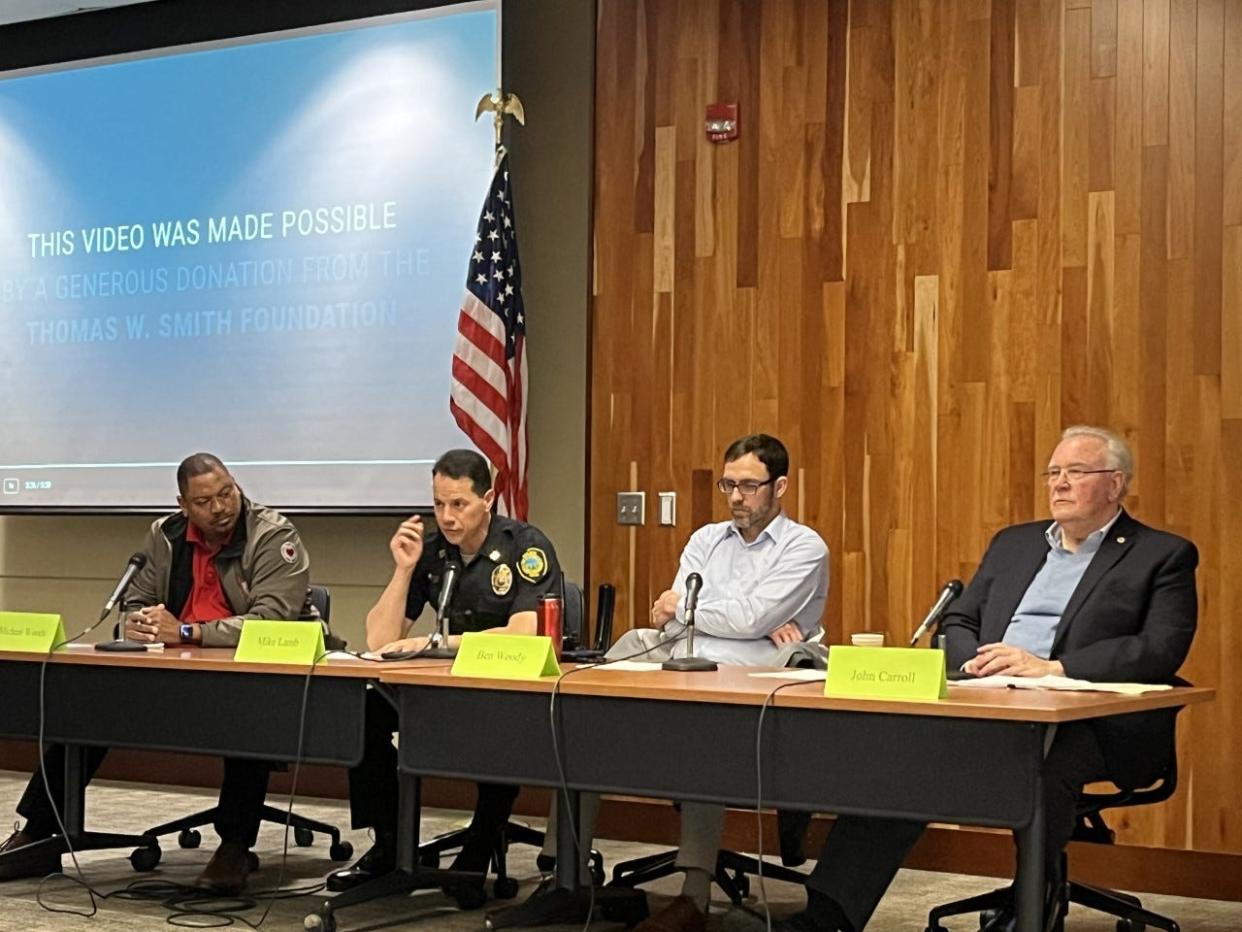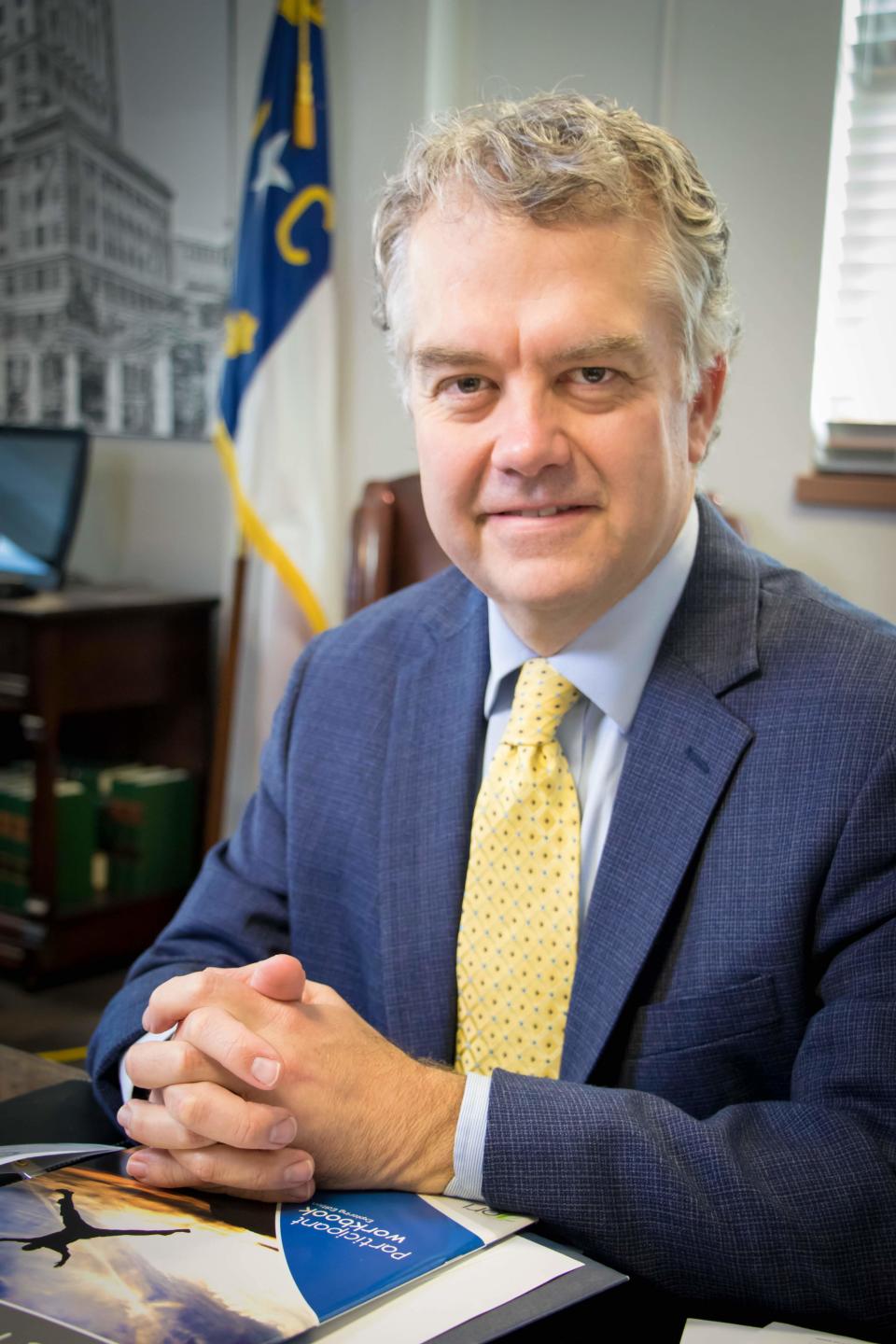Housing, homelessness, cops and crime: Downtown discussed at Asheville CIBO

- Oops!Something went wrong.Please try again later.
ASHEVILLE - Local leaders and community members again discussed the state of downtown, crime and Asheville's homeless population at a March 3 Council of Independent Business Owners meeting.
“This is a solvable problem in Asheville,” said Micheal Woods, executive director of the nonprofit Western Carolina Rescue Ministries.
Local business owners and employees are claiming that the problem is an increasingly dangerous downtown with a visible and growing population of homeless people. The problem is being exacerbated by rising rents, a short-staffed police department, a City Council that is not taking action to protect property owners and a local court system that is not holding criminals to account, community members have said.
More:'Uncomfortable, unsafe': Asheville business owners, employees demand action from council
Data from the Asheville Police Department says property crime is down 8% since March 2022, with a 32% decrease for the year to date, the Citizen Times reported March 1.
But concerns around downtown have extended beyond the last year, often tapping into a larger discussion of how the city has changed overall.
And police say that some crime is going unreported.

“If you point at one particular data set, from one short period of time, it doesn’t tell you what’s been happening overall in the city for the last five years, with violent crime and property crime," Police Chief David Zack told the Citizen Times on March 1. "There will be ebbs and flows, but again, we know there is a lot of things going unreported.”
At the CIBO meeting, APD Capt. Mike Lamb, who oversees the community engagement division, encouraged business owners to be willing to prosecute and to post signage warning against trespassing, a process completed through a city form.
Asheville has a “permissive environment,” he said. “And we need to change that culture.”
Two cops downtown
“Right now, downtown, we have two officers and maybe two working extra,” Lamb told the crowd at CIBO. “We used to have 12 officers, eight that were within our Charlie (downtown) District, and then two or three extra that would work in the evening. So, that’s how much lower our numbers are.”
Recent special operations targeting shoplifting, panhandling, graffiti, break-ins and shootings have netted “a lot of arrests,” he said. But, with APD’s understaffing, they come at a cost.
“Whenever we do these operations, we have to pull officers from other parts of the city to do this,” Lamb said. “So, if we’re doing an operation downtown, that means Haw Creek doesn’t have as much coverage, North Asheville doesn’t have as much coverage, South Asheville, West Asheville, all these areas.”
Past reporting:'Uncomfortable, unsafe': Asheville business owners, employees demand action from council
More:Asheville police offer tips to deter local business break-ins; What are they?
More:Blue Dream Curry House owner downsizes, calls for change in downtown Asheville
The department still has to prioritize emergency calls, he said.
A large share of officers who would have been working downtown left during the 2020 exodus of police officers, Lamb told the Citizen Times after the meeting.
APD spokesperson Samantha Booth said Feb. 28, the department is down 40% of sworn officers, with only 144 out of 238 sworn officers available on a daily basis.
Zack has said that police understaffing is a multifaceted issue that could take “years” to solve. In an interview with the Citizen Times last summer, he said that pay and benefits were major factors “in an environment where the 18,000-plus agencies across the nation are all fighting for the same recruits."
At a City Council retreat hours after the March 3 CIBO meeting, Zack told council members what he believed could make a difference: making the Asheville Police Department the highest paid police force in the state.
Housing concerns
Woods, with Western Carolina Rescue Ministries, said a lack of truly affordable housing was contributing to the problem.

“The problem that we have isn’t that we have a lack of shelter beds, and I’m going to make sure that I say that out loud,” he said. “Because, all of a sudden, there’s now a movement to produce more shelter beds. I don’t have a problem with another shelter, but that’s not the solution to our problem. What we have is we have people who are ready for safe, affordable housing. And let me say this: when we’re talking about affordable housing, I’m not talking about the definition that both the city and the county uses as affordable, because that does not address the people that we serve.”
A recent report from the National Alliance to End Homelessness noted that homelessness is exacerbated by the city's staggering affordable housing crisis, compounded by the impacts of the pandemic. Asheville is more expensive than 98% of other North Carolina cities and is home to the highest rents in the state.
More:For renters, Asheville area market the worst in NC, 5th worst in the US, study says
More:Asheville, Buncombe living wage shoots up to $20.10; minimum to afford 1 bedroom apt.
More:Fact checking the Asheville busing myth: Are homeless people being bused into the city?
The “large majority” of affordable housing in Asheville is “unsafe,” Woods said.
In a Sept. 27, 2022, presentation to the city’s Public Safety Committee, Zack noted that – alongside downtown – Asheville’s affordable housing complexes share the bulk of violent crime.
Police are set to provide an update on crime data at the next Environment and Safety Committee meeting.
Prosecutors, police meeting more frequently
In December 2021, Zack sent Buncombe County District Attorney Todd Williams a memo outlining concerns that Williams’ office “dismissed nearly every charged case involving criminal behavior routinely complained of by downtown businesses and residents.”
The memo, which was leaked, led to discussion of Williams’ priorities as the county’s top prosecutor.
Williams, who has been DA since 2015, ousted 24-year District Attorney Ron Moore, and has overhauled the DA’s office in major ways. In February 2022, he announced an unhoused diversion program that sought to remove "barriers to safe and stable housing by reducing the number of pending nonviolent misdemeanor charges for unhoused individuals," according to a Feb. 24, 2022, news release from Williams' office.
Asked about concerns – some raised in recent meetings – that his office was not prosecuting nuisance crimes, Williams said such concerns fall on judges and magistrates.

“Foremost, what I am hearing from victims of crime is their recognition of the inability of our public mental health, justice, and social services systems to effectively address the many causes of crime,” the DA said in a March 3 email to the Citizen Times. “The media appears to consistently modify that sentiment and present it as a perceived lack of prosecution, but the public in general is aware of the nuances.”
“What I am hearing from victims of crime is a frustration with magistrates and judges who are releasing suspects,” Williams said. “Magistrates and judges are the only ones in the system with the power to release suspects pre-trial and provide their rationales. The media and law-enforcement would do our community a great service if they would transparently and consistently communicate that when referencing judicial decisions to release.”
The DA’s office – along with judges – has been consulting more often with APD, Lamb said.
“We meet on a more regular basis now,” he said after the meeting. “We have a gun violence group that meets on a monthly basis. And then we have both prosecutors and judges that ask us what we want to do with the charges.”
In North Carolina, district attorneys set court calendars and can elect to dismiss charges. But judges and magistrates have considerable influence as well, the former able to grant pre-trial release, the latter setting initial bonds.
Data limited
Asked if there was any data showing how much property crime and violent crime is being attributed to unhoused people, Lamb said it was a work in progress.
“We don’t, and I think we’re working to get that,” he said. “It’s hard to pull offender data, measuring homelessness, because we’ve got a couple different addresses that folks use.”
On arrest warrants returned to the county magistrate’s office, unhoused people who have been charged will often be listed as living at the county jail, a shelter they were staying at or their address before they became homeless.
“So, the best way for us to try to do it is to pull those offender addresses that list those common areas,” Lamb said. “But we’re still missing a percentage even when we do that.”
According to 2022 point in time data, numbers of homeless people were up 21% overall ― 637 were experiencing homelessness in Asheville, up from 527 in 2021. The unsheltered count doubled, from 116 people in 2021 to 232 people identified as unsheltered in 2022.
More:2023 homeless point in time count: Where did you sleep last night? Why Asheville?
Other data provided by APD gives a general picture of the city’s ebbs and flows over the last 10 years, though. Logging incidents that police reported, it shows that 2022 had the third least number of reported violent incidents in the decade, with 58 reports last year, a drop of 29% from the previous year.
Property crime incidents were also down in 2022, with 336 reported, down from 351 in 2021. Since 2013 there were four other years that had more of those incidents reported than last year: 2013, 2018, 2019 and 2021.
Discussions around downtown could have major policy and funding implications with city leaders already hearing residents’ budget asks.
Budget adoption typically happens in June. April through June represents the "decision making" phase of the process, according to a Feb. 28 presentation from Taylor Floyd, the city's budget manager.
Ryan Oehrli covers public safety, breaking news, courts and other beats for the Citizen Times. Comments? Questions? Tips? Send them to coehrli@citizentimes.com or 252-944-6816. Follow Oehrli on Twitter at @oehrli. Please support daily and enterprise journalism with a subscription to the Citizen Times.
This article originally appeared on Asheville Citizen Times: Downtown Asheville crime concerns discussed by business owners

